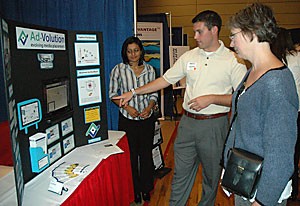For the first time, a student joined faculty and staff recognized for their achievements in scientific advances at the fourth annual Innovation Day yesterday.
David Stone, a graduate student in soil, water and environmental science, received the student award, and $1,000, for his development of a new iron and cement compound.
Two professors, Laurence H. Hurley and Nasser Peyghambarian, each won $10,000 – Hurley for cancer drug research and Peyghambarian for optics.
“”The purpose was to highlight and celebrate entrepreneurial faculty members on campus … to recognize those faculty members who are stepping outside of the lab and into the business world,”” said Molly Gilbert, director of media and public relations at the UA Office of Economic Development.
Entrepreneurs, researchers and businesspeople attended Innovation Day, which took place in the Student Union Memorial Center.
The event also featured panel discussions, including one titled “”Funding Your Innovation,”” where entrepreneurs could explore methods of funding and investment. A new panel was introduced this year called “”UA on the Leading Edge,”” which demonstrated the work researchers are undertaking at the UA.
Both sessions drew about 150 people each, Gilbertsaid.
In addition to the panels, a number of awards were given to faculty and students for their innovations, said Bruce Wright, associate vice president for economic development at the UA and chief operating officer of the UA Science and Technology Park.
An award was also given to John Schaefer, who was president of the UA from 1971 to 1982, Wright said.
“”He really recognized that we could become more than just a regional university; we could become a major research university,”” Wright said.
In addition to the panels and awards, Innovation Day featured a showcase of student-developed businesses and business plans produced by students in the McGuire Center for Entrepreneurship, part of the Eller College of Management.
One student business, Waste2Energy, aims to utilize technology that reforms waste products into products such as crude oil and gasses, said Andrew Nicholas, an economics senior.
The technology uses heated pressure chambers to break down the molecular structure of carbon-based materials that then reform into natural products, Nicholas said.
“”We’re … helping the inventor on the business aspect of it,”” Nicholas said. “”We have used our resources here at the UA, with a great supporting cast of some technical experts, to actually help us validate the technical aspects.””
The honorees and presenters represented many disciplines.
“”I think the point is that it’s very broad,”” Wright said. “”It spans all kinds of different disciplines and technology areas.””









